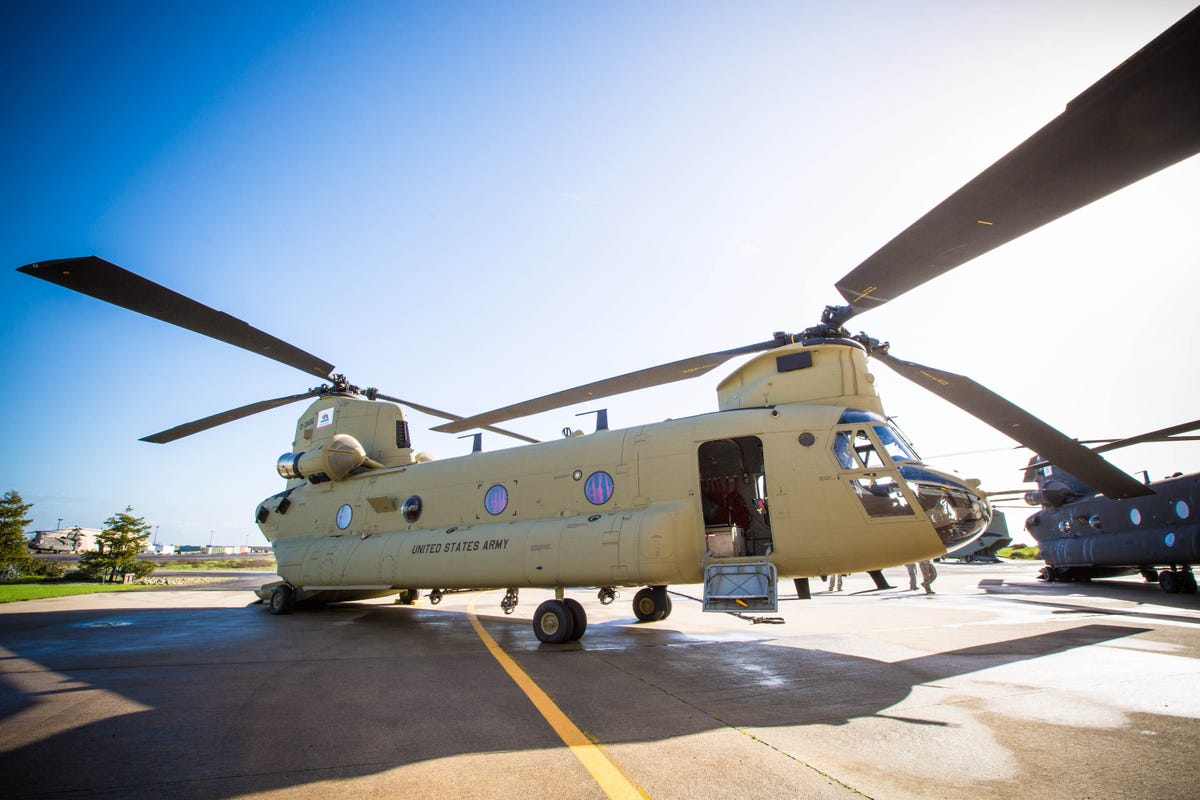Inside the Army's CH-47F Chinook helicopter (pictures)
The latest mainstream generation of the Chinook helicopter is the CH-47F, which features major upgrades, including fully digitized flight controls.

CH-47F Chinook
STOCKTON, Calif. -- The recent delivery of 10 new CH-47F Chinook helicopters to the California Army National Guard brought a significant upgrade from that airframe's aging predecessor, the CH-47D, one that should mean a higher operational readiness rate and a higher level of situational awareness.
Equipped with the Common Avionics Architecture Structure (CAAS), the CH-47F has an array of sensor and data technologies, making this a Chinook for the digital age.
"It practically flies itself," a crew member said. "In 15 years they will probably be fully autonomous."
Trained and equipped
In December 2003, the US Army ordered seven new CH-47F helicopters to replace those lost in action and, in January 2005, an additional 10 newly built CH-47F aircraft.
In November 2008, Boeing delivered the third CH-47F to the US Army, as it was certified as ready for combat in July 2007.
Since the completion of the first CH-47F Chinook in 2006, 18 US Army and National Guard units have been trained and equipped with the aircraft.
In late 2014, Boeing delivered the 300th CH-47F Chinook helicopter to the US Army, 75 days ahead of schedule.
Cockpit flight and mission management
Initially developed for the Special Operations Aviation MH-47G Chinook and MH-60L/M Black Hawk aircraft, the CAAS cockpit technology aboard the CH-47F is an open, nonproprietary system that uses commercial standards, helping to minimize the costs of the technology as well as upgrades.
The CAAS system incorporates cockpit flight and mission management as well as communications, navigation, weapons and mission sensor subsystems.
Maps and navigation
The fully integrated digital cockpit management system.
The Rockwell Collins digital cockpit includes five multifunction displays, moving map display, digital modem, BAE Systems digital advanced flight control system and data transfer system.
Center console display
The center console displays potential problems and warning dialogues critical to flight operations.
Inside the cockpit
Retired Maj. Alan Zulberti, left, has logged almost 4,000 hours aboard earlier-model Chinooks, having begun with 5 years of active duty in Vietnam.
Here, Zulberti and John C. Bailey Jr., right, check out the cockpit of one of the new CH-47F aircraft.
CH-47F cockpit
The CH-47F features the AN/ARC-231 Airborne Communication System from
Raytheon, which includes two UHF/VHF AM/FM radios. Older Chinooks were equipped with AN/ARC-164 (UHF-AM) and AN/ARC-186 (VHF-AM/FM) radios. The CH-47F is also equipped with two AN/ARC-201 SINCGARS radios, one AN/ARC-220 high frequency radio, and one L-Band BFT transceiver. Other CH-47F equipment includes the AN/APX-123(V) Identification Friend or Foe (IFF) transponder.
CH-47D cockpit
A look inside the previous Chinook model, the CH-47D, shows how significant the cockpit upgrade is.
Main cargo hold
Chinooks were designed primarily for cargo and transport missions, moving troops, artillery, ammunition, fuel and supplies.
In secondary missions, the helicopters are used for medical evacuations, disaster relief and search and rescue.
Load transport
The CH-47F Chinook has a triple hook system, providing stability to large external loads or even multiple loads at once.
Multiple external loads can be delivered to three separate destinations in one sortie. The central hook is rated to carry up to 12,000kg and the other two hooks 7,500kg each.
Large external loads, then, such as a 155mm howitzer, can be transported at speeds up to 260km/h using the triple-hook load configuration.
Propulsion system
One of the two Honeywell T55-GA-714A engines, which produce 4,777 shaft horsepower each.
Front view
A view from the front of one of the CH-47F Chinooks, parked at the Stockton Army Aviation Support Facility.
Interior main cabin
The main cabin can hold 33 fully equipped troops.
For medical evacuation, the cabin can accommodate 24 stretchers.
Flyover in Stockton, Calif.
The unit cost of a CH-47F is $37.94 million, according to the US Department of Defense.The airframe costs $24.08 million, the two T55-GA-714A engines cost $2.32 million -- $1.16 million each -- and the avionics package costs $1.51 million.
Chinook fly-by
A Chinook passes above the Stockton Army Aviation Support Facility during the induction ceremony on February 9, 2015.
Speeds greater than 175 mph
The CH-47F can reach speeds greater than 175 mph and transport payloads weighing more than 21,000 pounds.
Chinook helicopters were first introduced in 1962, and this is the sixth Chinook type designed for the US Army. Since then, 1,179 of the aircraft have been built.
Toward a century of Chinooks
The CH-47F modernization program is now in full production, intended to ensure this tandem-rotor helicoptor remains in service through the 2030s.
The Army says it is possible the Chinook will be an asset for a century or more to come.

